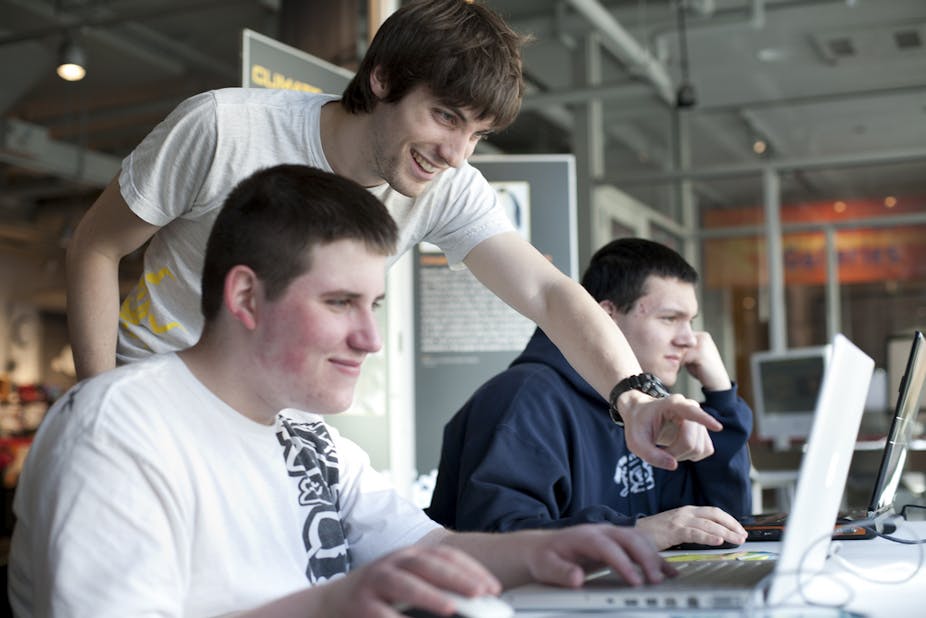Imagine a computer programmer. What does this person look like? What is this person doing? Is the person with anyone? What kinds of hobbies might he or she have?
Chances are that you imagined someone who is: male, white or Asian American, kind of geeky-looking and sitting alone at a computer.
This typifies the stereotypical image of computer science in American culture. And this image has only solidified over the past 30 years: so much so that high school girls say things like:
when I heard “computer science,” I pictured nerdy boys, who turned into nerdy bearded men, slouched over huge computers and click-clacking out codes that meant nothing to me.
The real problem is that this geeky representation may prevent girls from seriously considering a career in computer science. As it is, women are highly underrepresented in computer science. In recent years, only 18% of college degrees have gone to women.
I am part of an interdisciplinary team at the Institute for Learning & Brain Sciences at the University of Washington (UW). Over the past three years, our team, which includes researchers Sapna Cheryan and Andrew Meltzoff, has worked to uncover the effects of these stereotypes on girls.
The effects are real. But there are ways to counter them.
Stereotypes matter
We ran an experiment to see how showing a stereotypical or nonstereotypical computer science classroom would affect girls’ interest in taking a computer science class.
We decorated a UW classroom in two ways: first with a set of objects that we know students associate with computer science, and second with a set of objects that are not associated with computer science.
The stereotypical objects included the most obvious things, such as computer parts and books, but also other stuff considered “geeky,” like Star Trek posters. Our nonstereotypical objects included things that you might typically find in a classroom or office space, such as potted plants and nature posters.
We showed photographs of both classrooms to high school girls and boys. We then asked them which classroom they liked better and how interested they were in each.
What we found was that stereotypes mattered. But only for girls.
Girls overwhelmingly preferred the nonstereotypical classroom (68% of girls said so), while boys had no preference.
Initially, only about 13% of girls told us they were interested in taking a computer science class, but girls were almost three times more likely to be interested (35%) when the classroom was not stereotypical.
Girls feel they don’t belong
So, why do girls care about stereotypes?

Our data show they make girls feel like they don’t belong. And the less that girls felt they fit the stereotypes, the less interested they were in taking computer science in the stereotypical classroom.
Okay, then how do we counteract these perceptions?
We need to show girls a broader image of computer science. If girls feel that they can belong in computer science classrooms, then – our findings show – they’ll be more likely to give it a fair shot. When girls feel that they belong, it can transform their experience in fields dominated by men.
And this is not just about classroom design – it’s about whether we perpetuate the same old images or change them to show a more diverse image of computer science.
Bringing change
Stereotypes are stubborn and hard to shift, but our lab has found three promising strategies that could help computer science:
redesign the physical environment so that girls feel welcome
show diverse role models, whose personalities and interests demonstrate that lots of different kinds of people can be computer scientists
change the media stories (for example, using newspaper and magazine articles about computer science): tell girls how stereotypes about computer science are not accurate.
There is an effort in the United States to make computer science education available to more students. Thanks to the work done by nonprofit groups such as code.org and others, the demand for such education is increasing.
Almost 10,000 schools across the United States recently requested help in starting computer science classes. Last year, the White House announced initiatives to support computer science education in K-12 schools.
We need to get more girls to sign up for these classes. In a booming industry, girls are missing out on well-paying jobs. And the gender disparity hurts tech companies too. A less diverse workforce means less innovation and problem-solving.
The first step is to show girls that they belong in computer science.

